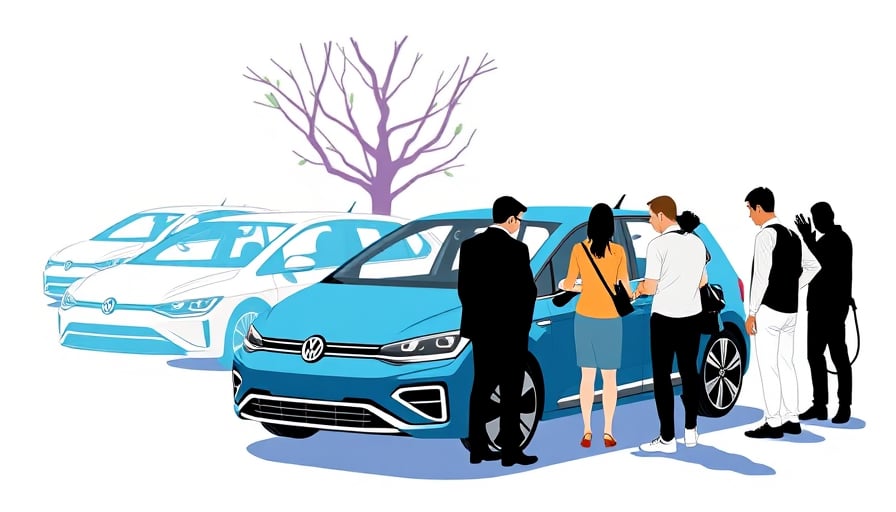Executive Summary
Volkswagen AG (VW) has announced a series of strategic initiatives aimed at consolidating its position within the global electric‑vehicle (EV) market. The German automaker is developing an in‑house system‑on‑chip (SoC) for smart driving in partnership with Chinese technology specialist Horizon Robotics, extending the return period for its ID range in the United Kingdom, and introducing advertising on the infotainment displays of its ID 7 and other models. These moves represent a broader corporate effort to strengthen local research and development (R&D) capabilities, enhance customer confidence, and diversify revenue streams in a sector increasingly characterised by rapid technological change and heightened consumer scrutiny.
1. Strategic Context
1.1 Technological Autonomy in a Global Supply‑Chain Landscape
The automotive sector has witnessed a surge in demand for advanced driver‑assist systems (ADAS) and fully autonomous capabilities. By developing an in‑house SoC through its joint venture with Horizon Robotics, VW is reducing dependence on external semiconductor suppliers such as Mobileye, Nvidia, and Qualcomm. This strategy aligns with a global trend among premium automakers—Toyota, Ford, and Hyundai—who are investing heavily in in‑house chip design to secure competitive differentiation and protect intellectual property.
1.2 Market‑Specific Customer‑Centric Initiatives
The extension of the return period for the ID range in the United Kingdom reflects a shift towards greater consumer flexibility. The 100‑day return window follows the “ID Promise” scheme, signalling VW’s commitment to building brand trust in a highly price‑sensitive market. Similar programmes, such as Tesla’s “Free Return” policy during the Model 3 launch, illustrate how automakers are redefining after‑sales engagement to capture market share in a crowded EV landscape.
1.3 New Revenue Streams in the Connected‑Car Ecosystem
Embedding advertising on the infotainment displays of the ID 7 and other models introduces a novel monetisation avenue. This approach mirrors practices in the telecommunications industry, where data‑plan providers offer targeted advertising on mobile platforms. By leveraging its connected‑car platform, VW can tap into a global advertising market estimated at USD 70 billion by 2026, thereby offsetting margin pressure from battery cost reductions.
2. Cross‑Sector Analysis
| Sector | Parallel Initiative | Key Insight | Potential Impact |
|---|---|---|---|
| Semiconductor | In‑house SoC development | Vertical integration reduces supply‑chain risk | Enhances technological sovereignty |
| Telecommunications | Targeted in‑vehicle advertising | Data‑driven monetisation | Diversifies revenue, improves UX design |
| Retail | Flexible return policies | Customer retention through trust | Boosts brand perception, mitigates churn |
| Finance | Subscription‑based connectivity | Recurring revenue model | Aligns with EV ownership economics |
By examining these cross‑sector parallels, VW demonstrates an adaptive business model that can translate best practices from unrelated industries into the automotive context. The integration of advertising, for instance, follows the data monetisation logic that has proven successful in mobile and streaming services, while the extended return policy adopts retail’s customer‑first philosophy to counteract price sensitivity.
3. Competitive Positioning
| Competitor | Current Focus | VW’s Differentiator |
|---|---|---|
| Tesla | Proprietary Full Self‑Driving (FSD) chip | VW’s SoC partnership offers a tailored, cost‑effective alternative |
| BYD | In‑house battery manufacturing | VW’s joint venture with Horizon Robotics mirrors BYD’s vertical integration model |
| Ford | Connectivity‑first strategy | VW’s advertising initiative expands its revenue base beyond vehicle sales |
Volkswagen’s strategy aligns with a broader industry pivot towards “platform‑centric” models, where the vehicle functions as a service ecosystem. By embedding advertising and extending return periods, VW is positioning itself as both a technology provider and a consumer‑experience curator, thereby broadening its competitive moat.
4. Economic and Regulatory Factors
- China’s Semiconductor Policy: The Chinese government’s “Made In China 2025” initiative encourages local semiconductor development, making the SoC joint venture strategically timely and potentially eligible for subsidies.
- UK Consumer Protection Laws: The extended return window must comply with the Consumer Rights Act 2015, which mandates a 30‑day cooling‑off period for new purchases. VW’s 100‑day policy is legally permissible but requires careful communication to avoid consumer confusion.
- Advertising Regulations: Data protection laws such as the UK’s GDPR and China’s Personal Information Protection Law (PIPL) impose strict requirements on in‑vehicle ad data collection and usage. VW will need robust compliance frameworks to mitigate legal risk.
These factors illustrate that VW’s initiatives are not only market‑driven but also heavily influenced by national policy and regulatory environments. The company’s ability to navigate these complexities will be a critical determinant of long‑term success.
5. Risk Assessment
| Risk | Likelihood | Impact | Mitigation |
|---|---|---|---|
| Technology Failure (SoC performance issues) | Medium | High | Rigorous testing, phased rollout, partnership with experienced silicon vendor |
| Consumer Backlash (advertising perceived as intrusive) | Medium | Medium | Transparent opt‑in features, user‑control interfaces, continuous UX evaluation |
| Regulatory Compliance (GDPR/PIPL breaches) | Low | High | Dedicated data‑privacy team, regular audits, compliance certifications |
| Supply‑Chain Disruption (chip shortages) | High | Medium | Diversified supplier base, buffer inventory for critical components |
A balanced approach that includes technical safeguards, user‑experience design, and proactive regulatory engagement will help VW mitigate these risks while pursuing growth.
6. Conclusion
Volkswagen’s recent initiatives demonstrate a calculated effort to embed technological autonomy, customer‑centric policies, and diversified revenue models into its corporate strategy. By leveraging a joint venture with Horizon Robotics for an in‑house SoC, extending vehicle return periods in a price‑sensitive market, and monetising infotainment displays through advertising, VW is aligning itself with emerging industry trends that favour vertical integration, platform thinking, and data‑driven monetisation.
The company’s actions resonate across multiple sectors, reflecting an adaptive mindset that draws lessons from semiconductors, telecommunications, retail, and finance. While regulatory and technological risks persist, VW’s proactive stance and cross‑sector insights position it well to navigate the competitive challenges of the evolving electric‑vehicle landscape.
